Silent computer: only wire cutters and a soldering iron. Success story

We have a desktop. We are working - we are writing code or watching seals, and this box is roaring nearby. We have wire cutters, a soldering iron, a blue electrical tape, a few wires, a little shrink cambric and basic knowledge in electrical engineering and computer design. Is it possible to somehow dig this box so that it roars at least a little quieter?
First two simple problems from theory. We are talking about noise, about cooling.
Why is the computer noisy? Because the fans are spinning.
And how much the computer is noisy, and how does it depend on the fans?
Let's solve a simple problem: this is the trick - and the fan speed will drop by half. How many decibels will the noise decrease?
Fans - this is important, this is heat dissipation, electronics should not overheat.
Then another task: the cooler blows around the processor. The processor temperature is 35 degrees Celsius. And suddenly the processor doubled its heat dissipation. What will be the temperature of the processor?
The noise of the system unit consists of the noise created by coolers and the noise of hard drives.
Let's skip hard drives, this cannot be changed and this is not the main source of noise.
Where does cooler noise come from? The air flowing around the radiator is the time and the noise of the mechanics of the cooler itself: beating in bearings, sounds emitted by the cooler windings (uneven cores, magnetostriction etc.)
Turbulence

We calculate the Reynolds number for the cooler-radiator system.
Re = (flow rate) * (characteristic size) / (kinematic viscosity)
According to the study , the cooler’s productivity varies between 20-60 cubic meters per hour, or 0.005 - 0.015 cubic meters / second. We will take 0.01 cubic meters / second as the average for coolers in the
The diameter of the average cooler is 7 cm = 0.07 m.
Then the flow rate = (productivity) / (area) = 0.01 / (pi * 0.07 * 0.07 / 4) = 2.6 meters per second
Typical size we already have - this is the diameter.
Then Re = (2.6) * (0.07) / (16/1000000) = 11000
According to the same Wiki and other sources,at this number Re, the air flow is turbulent .
During a turbulent flow in the air, vortices arise. A vortex is an independent formation, breaking off from the fan blades, vortices form jumps in air pressure. The same thing happens when a vortex formation hits a hard surface. Pressure surges from numerous vortices create the same noise sound that comes from a working cooler.
Is it possible to make the flow laminar, i.e. irrotational, so that there is no noise? Even with a four-fold decrease in the air flow rate, the flow will remain turbulent, vortex (the Re number becomes 2500).
However, there is an intuitive assumption that reducing the air flow rate will reduce the noise emitted. More about this below.
The noise of the cooler mechanics.
All sound effects from the mechanics of the cooler directly depend on the force created by the current flowing through the windings. The nature of these sound effects is diverse and complex, and here it does not make sense on the fingers. However, it is obvious that with a decrease in the current flowing through the windings, and with a decrease in the frequency of rotation of the cooler, the sound effects will decrease.
Indeed, why argue on the fingers, if there is such a study. It is dedicated to fans, but a cooler is a fan, all conclusions will be fair. Only the flow rate appears in it, but from the theory of fans it follows that the air flow, and therefore the flow velocity, is directly proportional to the rotational speed (rpm). We halve the rotation frequency - the flow rate is half as much.
So, all the fan noise is proportional to the speed. We quote a study
It is known that turbulent noise is a quadrupole type source, and its sound power is proportional to ~ u8, and vortex noise is a dipole type source, and its sound power is ~ u6, where u is the peripheral speed. With a decrease in the rotational speed, the rotational noise also decreases, which has a dipole (load noise) and monopolistic (displacement noise) nature, and their sound power is proportional to ~ u6 and ~ u4, respectively.
So, the power of turbulent noise is proportional to the eighth (!) Degree of speed. That is, the sound pressure level of the noise is proportional to the fourth power of the frequency (level = root of power = root of 8 degrees = 4 degrees).
Wow!
Here is the volume scale (digits in dB) Audibility
threshold 0
Ticking a wristwatch 10
Whisper 20
Sound of a wall clock 30
Muffled conversation 40
Quiet street 50
Normal conversation 60
Noisy street 70
Let's take the system unit volume level 65 dB on this scale - the average between a normal conversation and a noisy by the street.
Reducing the fan speed by half will reduce the noise from turbulent air flows by 2 ^ 4 = 16 times, or by 24 dB, that is, the volume level will become equal to a muffled conversation. Good effect!
Thermodynamic calculation
We wrote above - we will reduce the speed by half. Why in two? Why not at twenty? Or even turn off the fans, there will be no noise? After all, it requires some kind of air flow for cooling, here we reduce it - and what will happen, for example, with a processor?
Let's solve the problem that is at the beginning of the post.
So, the processor temperature = 35 degrees, the processor heatsink is regularly blown by the cooler, the flow rate does not change.
The processor doubled the heat output. What will be the temperature of the processor with a constant flow of air?
Consider the process of blowing. Imagine that the “cooler-heatsink-processor” system is a black box that gives off heat to the air stream. The amount of heat is proportional to the temperature difference between the processor and the incoming air at the inlet, that is (the processor temperature is the temperature of the air entering the cooler).
Inlet air temperature = temperature inside the system unit. Let's take it equal to 30 degrees.
Total temperature difference between the processor and the free air = 35 - 30 = 5 degrees. If the processor doubles the heat generation, the temperature difference also doubles, that is, it becomes equal to 5 * 2 = 10 degrees.
And the processor temperature will be equal to the air temperature + difference = 30 + 10 = 40 degrees (instead of 70, which immediately come to mind)
And what will happen to the temperature of the processor if you reduce the cooling flow rate by half?
According to the Kuhling Physics Handbook K, the amount of heat carried away from the “air-solid wall” surface is proportional to the temperature difference and the root of the air velocity. If you reduce the air flow rate by half, then to remove the same amount of heat, the temperature difference will grow to the root of 2 times, that is, about 1.4 times.
The final formula:
CPU = Air + (CPU initial - Air) * root ((initial rotation speed / final rotation speed))
Let's do a couple of real calculations, from practice.
CPU initial = 42 degrees
Airflow = 20 degrees (system unit open)
Rotation speed reduced by 2 times (from 2000 to 1000 rpm)
CPU = 20 + (42-20) * 1.4 = 51 degrees
Worse conditions of the
Processor initial = 60 degrees (old hot Athlon)
Air = 20 degrees (the system unit is open)
Rotation speed reduced by 2.5 times (from 2000 to 800 rpm)
Processor = 20 + (42-20) * 1.4 = 76 degrees
We see that even on a hot processor (temperature difference = 40 degrees) and a decrease in rotational speed by 2.5 times (= noise reduction by 31 dB), the processor temperature remains within acceptable limits with a good margin.
Here on the knee are the test results on the Core i5 series 3 processor, it can be seen that even during a stress test, the temperature increases by several degrees with a decrease in rotational speed by 2.5 times.
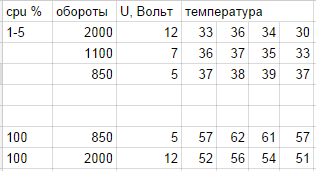
Total: theoretically, reducing the fan speed by 2-2.5 times is safe for the electronics that it cools.
How to reduce the fan speed? Reduce supply voltage.
And how does the rotation speed depend on the supply voltage? Approximately linear, see label above.
We begin to upgrade the system unit
First of all, we have at least two fans - one in the power supply and one on the processor. Maybe one more on the video card, on older models - also on the motherboard.
What we will do:
1) disconnect all fans from the + 12V power supply
2) connect them together and connect to the + 5V power supply
3) test
1) So, we get and disassemble the power supply.
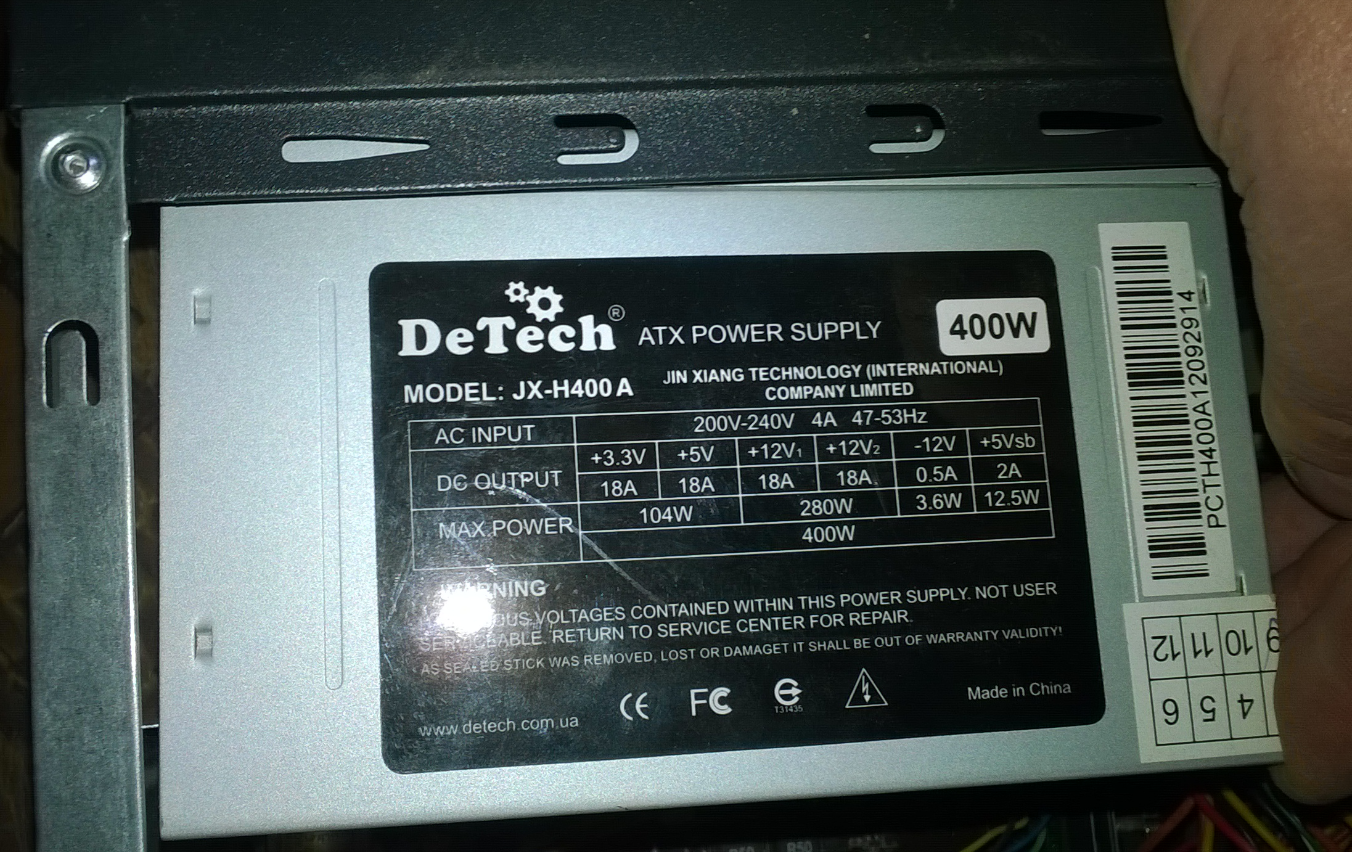
The fan just gently nibbles from the board (there may be a connector, or it may not be, it doesn’t matter). Solder the long wires to the wires coming from the cooler, bring them out
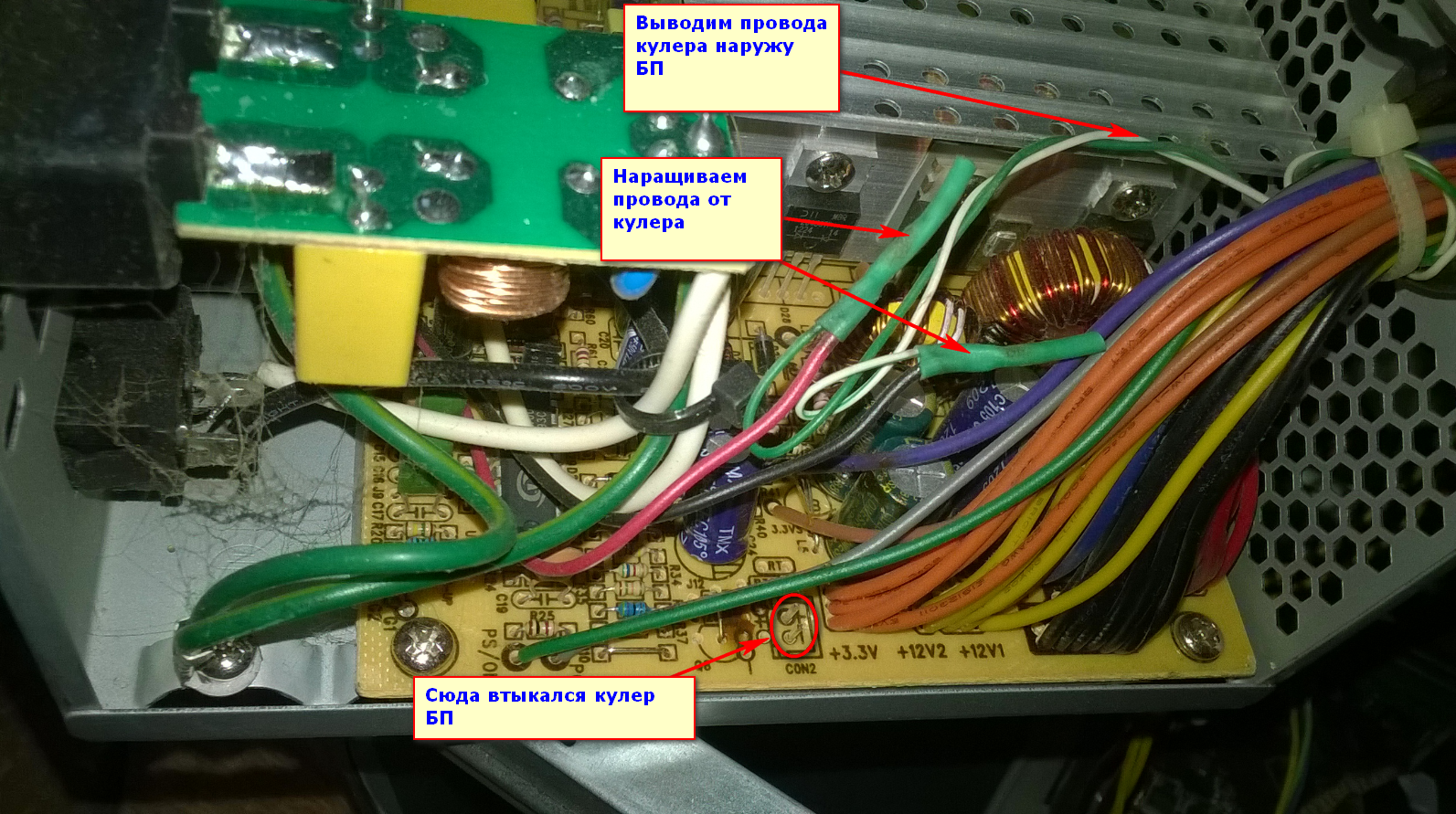
We bite off the processor cooler all the wires, we do the same operation. A processor cooler can have three or four wires, respectively. ground, + 12V, rotation sensor and (optional) speed control. We are only interested in + 12V, ground and everything else can be left directly in the connector
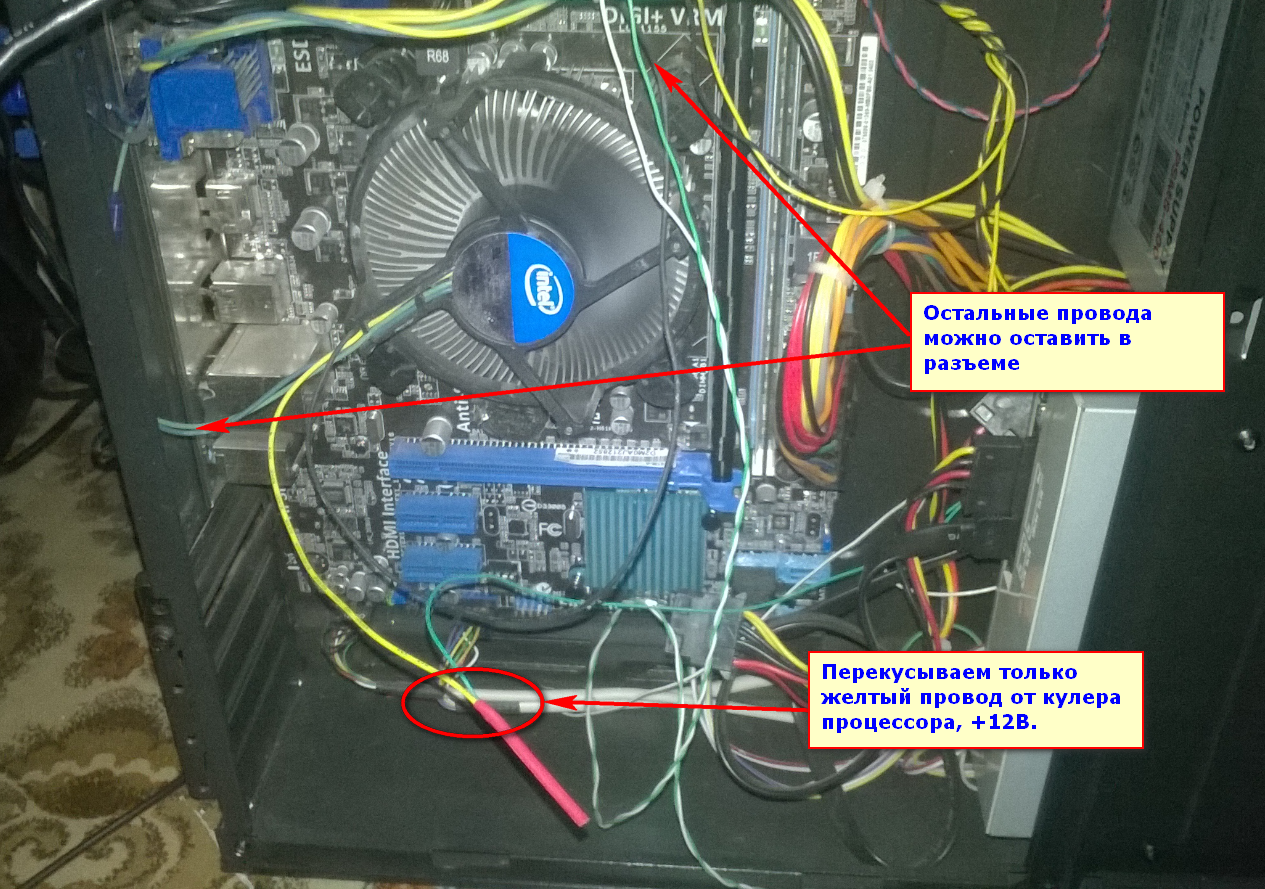
But you can also bite the ground and + 12V, this is better (this is Pentium4)

If there is a cooler on the video card - the same thing: bite off and extend the wires
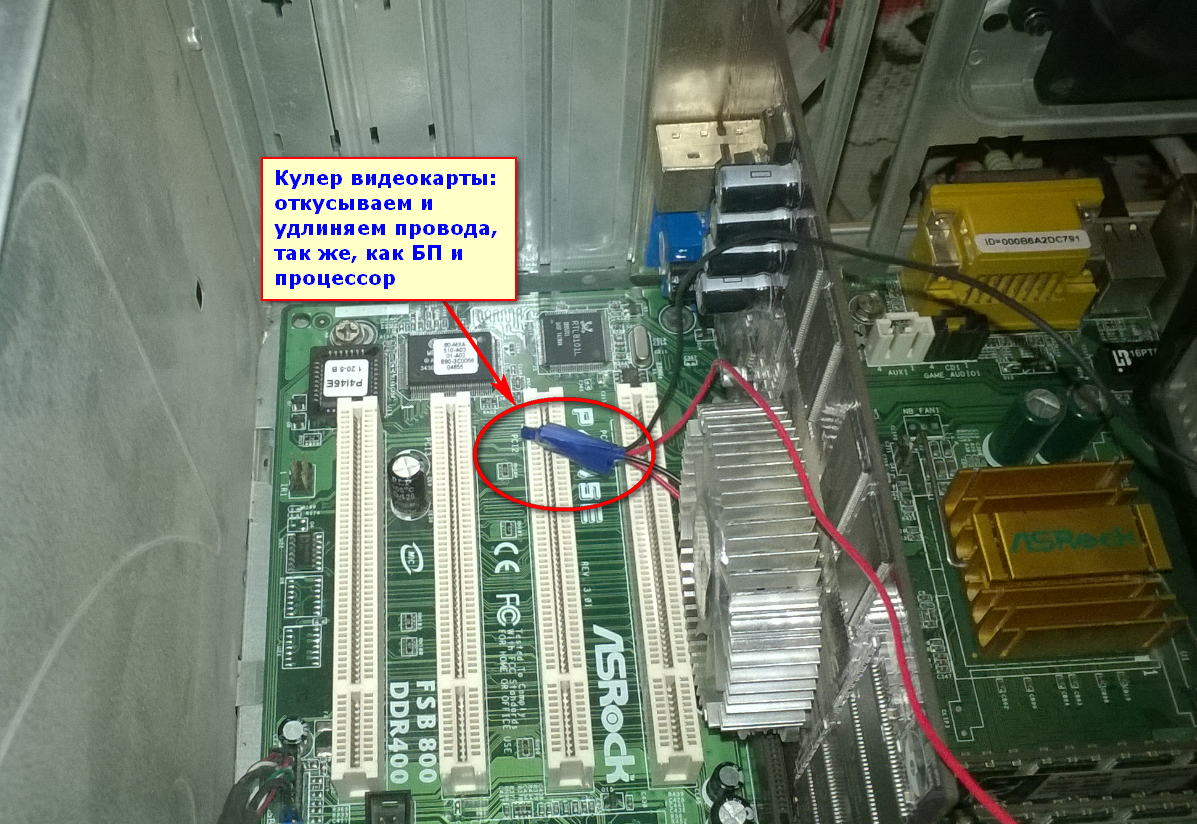
Another video card, this is GeForce 8600 gts
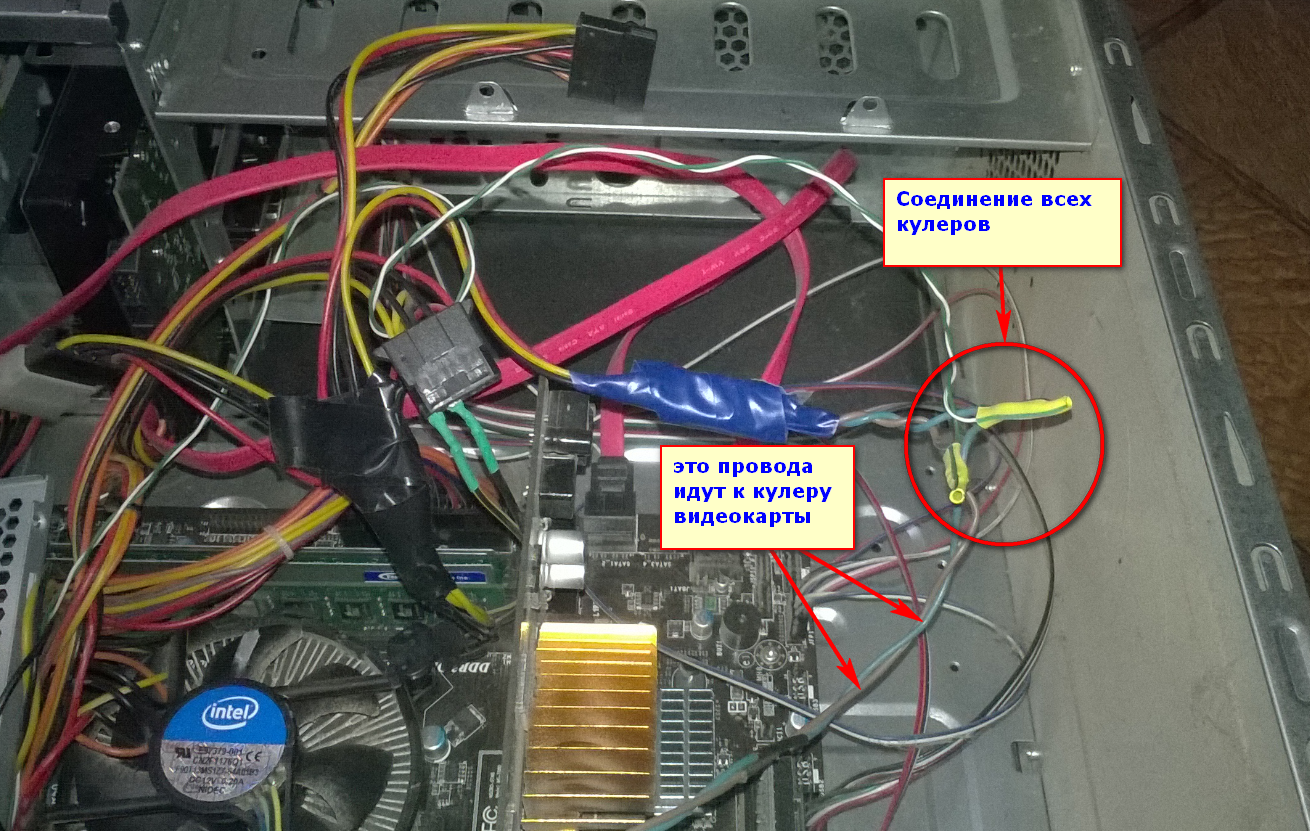
Warning!
1) make sure that the soldered joints are reliable, pull them for durability
2) in no case do not use electrical tape for insulation. Only shrink cambric, electrical tape - only for temporary mechanical fixation of wires
3) proceed from the principle that everything that can be closed –– it will be closed –––––––––––––––––––––––––––––––––––––––––––––––––––––– will fall off
; about it when this node goes down. Do it reliably.
2) We connect all the wires from the coolers, observing the polarity. As a result, you get two wires - plus and minus of the entire computer cooling system (all coolers connected together).
Next, the task will arise - how to connect to the power connector. You can unsolder and use pins from old CD / DVD drives or faulty hard drives (this is better, more reliable - you won’t pull it out)

or pins from motherboards. But such a connection must then be fixed mechanically, at least for the first time with electrical tape, such pins are much weaker
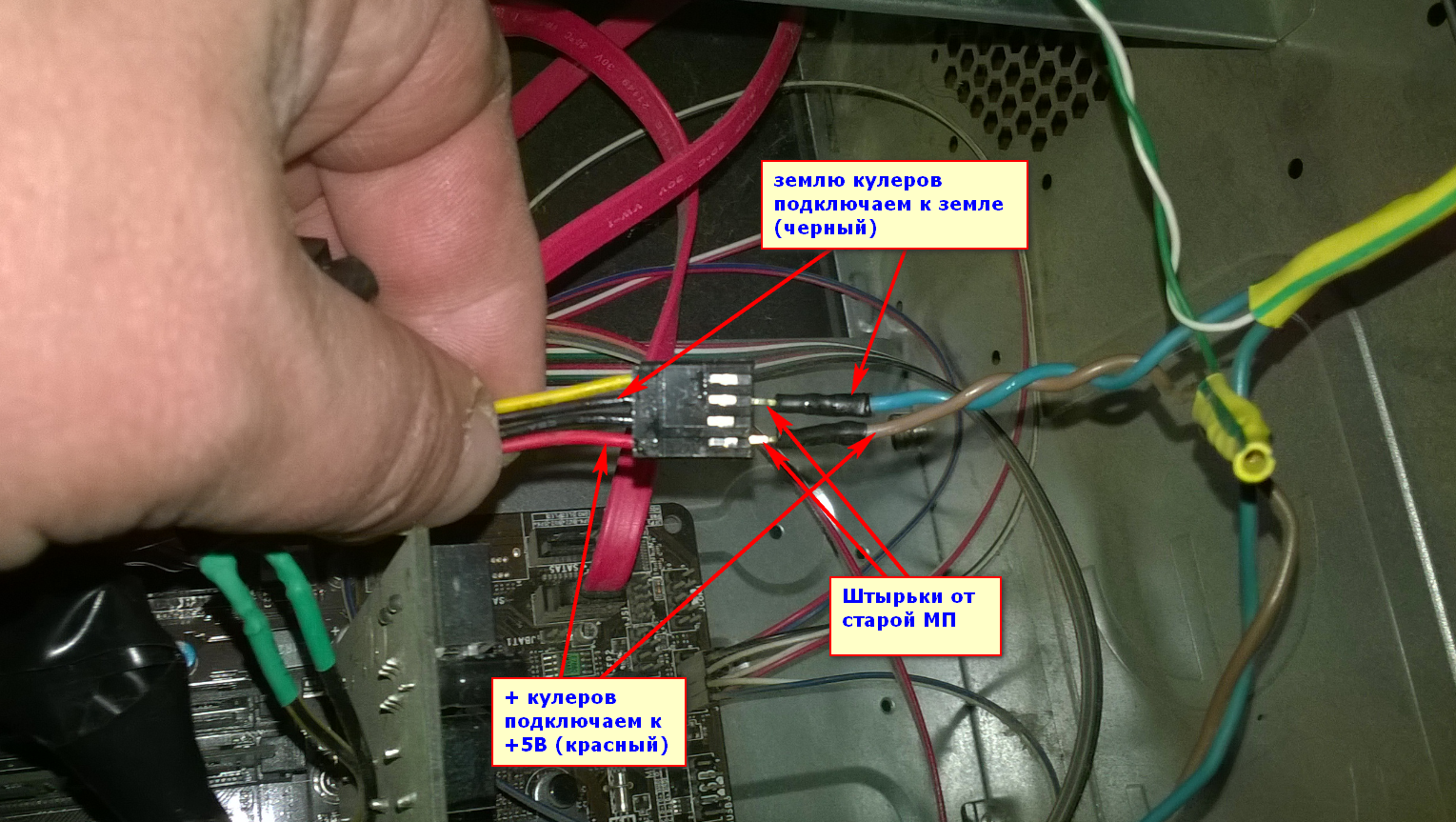
3) check everything carefully, pull the wires so that nothing suddenly flies out. Getting ready to turn on
First turn on
Be prepared to quickly inspect all fans immediately after turning on.
Turn on!
Quickly inspect and check the fans - they all need to spin. If suddenly something is worth it, turn it off immediately (we will consider this situation below)
If all the fans spin - approx. The PSU fan can be checked by attaching a piece of paper to the PSU - it should blow weakly.
OK
Your BIOS may begin to swear - they say that the PSU fan is not spinning or low revs or is not regulated. Go into the BIOS, put the CPU FAN to ignore.
Ok.
Everything! Enjoy the silence!
Run anything that shows the temperature of the processor - CoreTemp , RealTemp etc. Monitor the temperature for the first few days. Look at the fans.
And enjoy the silence!
How quiet is the computer after such a rework?
Quite quiet. Only the hard drive is audible.
Are there any risks of such a rework?
Not. You can always switch the power of all fans back to + 12V, get back exactly the same as it was
What to do in a situation when one of the fans does not spin when turned on?
Perhaps he does not have enough torque to start (although this situation has never been observed). In this case, power all the fans not 5V, but 7V. How?
To supply + 5V power, we connected + fans to + 5V, and the ground of the fans to earth. Connect + fans to + 12V and ground to + 5V. In this case, the fans will be 12-5 = 7V. A little noise will appear, however it is much quieter than it was.
How many computers have been redone in this way?
Since 2008, the author of these lines has personally upgraded several dozens of different types: from Pentium4 to Core i5. The entire line of Intel families between the above processors: Core2Duo, Celeron G ***, Pentium G *** and others. There are fewer machines on AMD processors, but still - from old ones with socket 939 to new ones.
Were there gaming or overclocked overclock computers?
No, and here it is worth considering whether such upgrades are needed for these computers.
Have problems been observed?
Associated with the modernization (overheating, failure of the cooled units) - no
How long does such an upgrade take?
About two to three hours.
How do computers upgraded in this way behave in the summer?
As usual. No failures recorded
Any additional. service measures?
Perhaps it makes more sense to blow dust and clean the computer. By the way, less dust accumulates in such a computer (apparently due to the smaller volume of air passed through)
And what is the know-how?
Nothing. The method described above has long been known to electronic engineers and is actively used. Auto publications just tried to bring the theoretical base under such modernization and showed examples of practical implementation.
Is it possible to do something similar on laptops?
In no case! The electronics of the laptop work in very difficult thermal conditions, and the cooling system is different from the desktop.
UPD2 And in conclusion. Nevertheless, before doing anything with the cooling system, do an analysis.
1) detect the temperature of the motherboard with any program (it can be considered equal to the temperature inside the system unit) and the temperature of the processor
2) run a stress test for the processor (available in many programs)
3) detect the temperature of the processor 10-15 minutes after starting the stress test
4) Perform a calculation of the processor temperature when the speed decreases (according to the formula in the article).
If the final result is acceptable, you can redo it. If you get a temperature close to the limit for the CPU, refrain from these alterations.
(But this situation refers more likely to the clause on gaming / overclocking machines)
